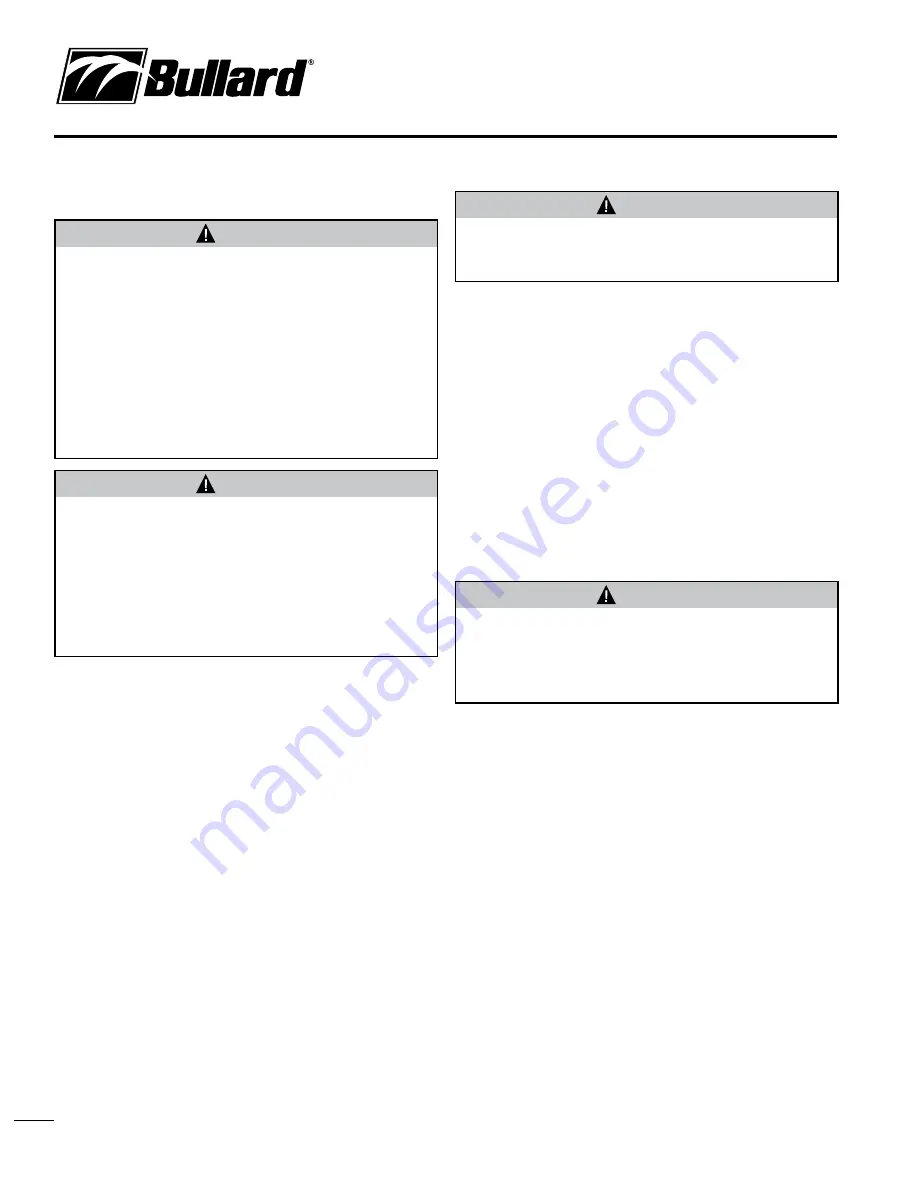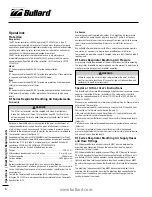
www.bullard.com
Inspection, Cleaning and Storage
Bullard RT Series respirators have a limited service life. Therefore, a regular
inspection and replacement program must be conducted.
Bullard RT Series respirators and all component parts and assemblies should
be inspected for damage or excessive wear before and after each use to
ensure proper functioning. Immediately remove the respirator from service
and replace parts or assemblies that show any sign of failure or excessive
wear that might reduce the degree of protection originally provided.
Use only Bullard RT Series respirator components and replacement parts
manufactured by Bullard and approved by NIOSH for use with these
respirators.
Since respirator use and the quality of maintenance performed vary with
each job site, it is impossible to provide a specific time frame for respirator
replacement.
Inspect all components of this respirator system during cleaning and before
and after each use for signs of wear, tear or damage that might reduce the
degree of protection originally provided. Respirators used by more than
one person must be cleaned, inspected and sanitized after each use. If not
cleaned, contamination may cause illness or disease.
Hood
Inspection
Inspect the hood material for rips, tears, or damage from excessive wear that
might reduce the degree of protection originally provided. Inspect the inner
neck cuff for elasticity. The respirator’s plastic lens should be inspected for
cracks, scratches or any other signs of damage.
Disassemble the breathing tube from the hood by removing the nylon hose
clamp. To remove the hose clamp, slide the locks sideways in opposite
directions.
If damage is detected, replace immediately with Bullard replacement part(s)
or remove the respirator from service.
Cleaning
Bullard does not recommend laundering the hood. When the hood becomes
dirty, it should be discarded and replaced. The respirator’s plastic lens should
be hand-sponged with warm water and mild detergent, rinsed, and air-dried.
After cleaning and before reassembling, once again carefully inspect parts for
signs of damage.
8
Inspection, Cleaning and Stor
age
WARNING
Failure to heed these instructions could result in death or serious injury.
LEAVE WORK AREA IMMEDIATELY IF:
- Any respirator component becomes damaged
- Airflow into respirator hood stops or slows down
- Air pressure gauge drops below the minimum specified in the
Breathing Air Pressure Table
- Pressure is felt in the ears
- Breathing becomes difficult
- You become dizzy, nauseous, too hot, too cold, or ill
- You taste, smell, or see contaminants inside
respirator hood
- Your vision becomes impaired
WARNING
Do not store respirator in your work area or leave it unattended in
a contaminated environment. Respirable contaminants can remain
suspended in the air for several hours after work activity ceases,
even though you may not see them. Proper work practice requires you
to wear the respirator until you are outside the contaminated area.
If you place or store the respirator in a contaminated environment,
contaminants, dirt, and dust could get into the respirator. When you put
the respirator back on, you could breathe in contaminants upon reuse.
Failure to heed these instructions could result in death or serious injury.
WARNING
The air you breathe will not be clean unless the respirator you wear
is clean. Failure to heed this warning could result in death or serious
injury.
WARNING
Do not use volatile solvents for cleaning this respirator or any parts and
assemblies. Strong cleaning and disinfecting agents, and many solvents,
can damage the plastic parts and reduce the protective properties of
the respirator. Failure to heed these instructions may result in minor or
moderate injury and/or equipment damage.






















